Collapsing stars, supernovae, and gamma-ray bursts
by
Hans-Thomas Janka
When massive stars die, they don't
just fade away. Their lives end in the most spectacular and most
luminous explosions that we know. For weeks they can become nearly as
bright as a whole galaxy. The stellar debris is expelled with
velocities up to ten percent of the speed of light and an energy of
motion that equals the radiation of the Sun during its whole life. In
rare cases this amount of energy can even be released in an enormously
intense flash of gamma radiation. Such a gamma-ray burst outshines all
stars of the universe for a period of seconds to many minutes and can
be accompanied by a stellar explosion ten or even fifty times more
energetic than usual.
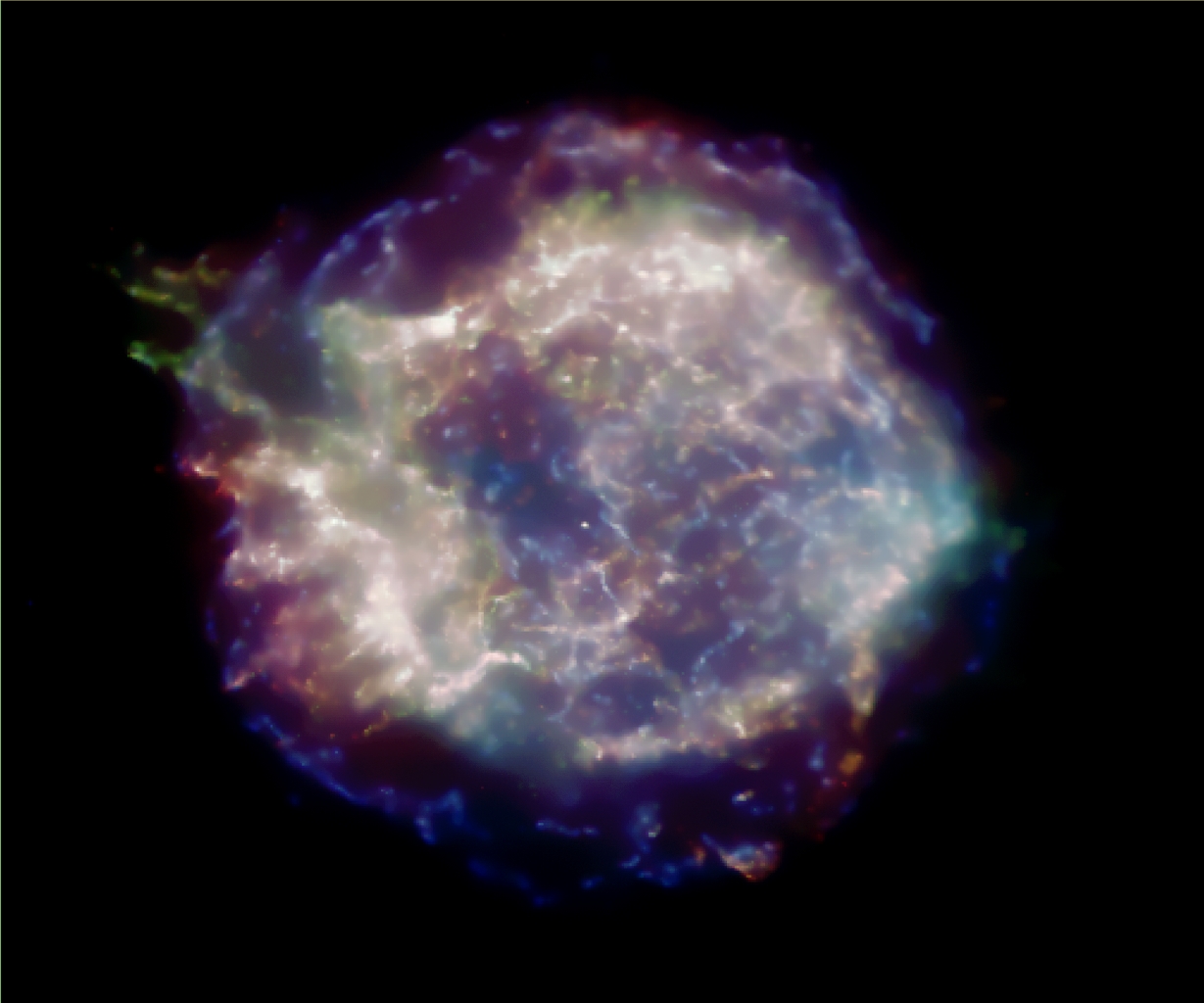 |
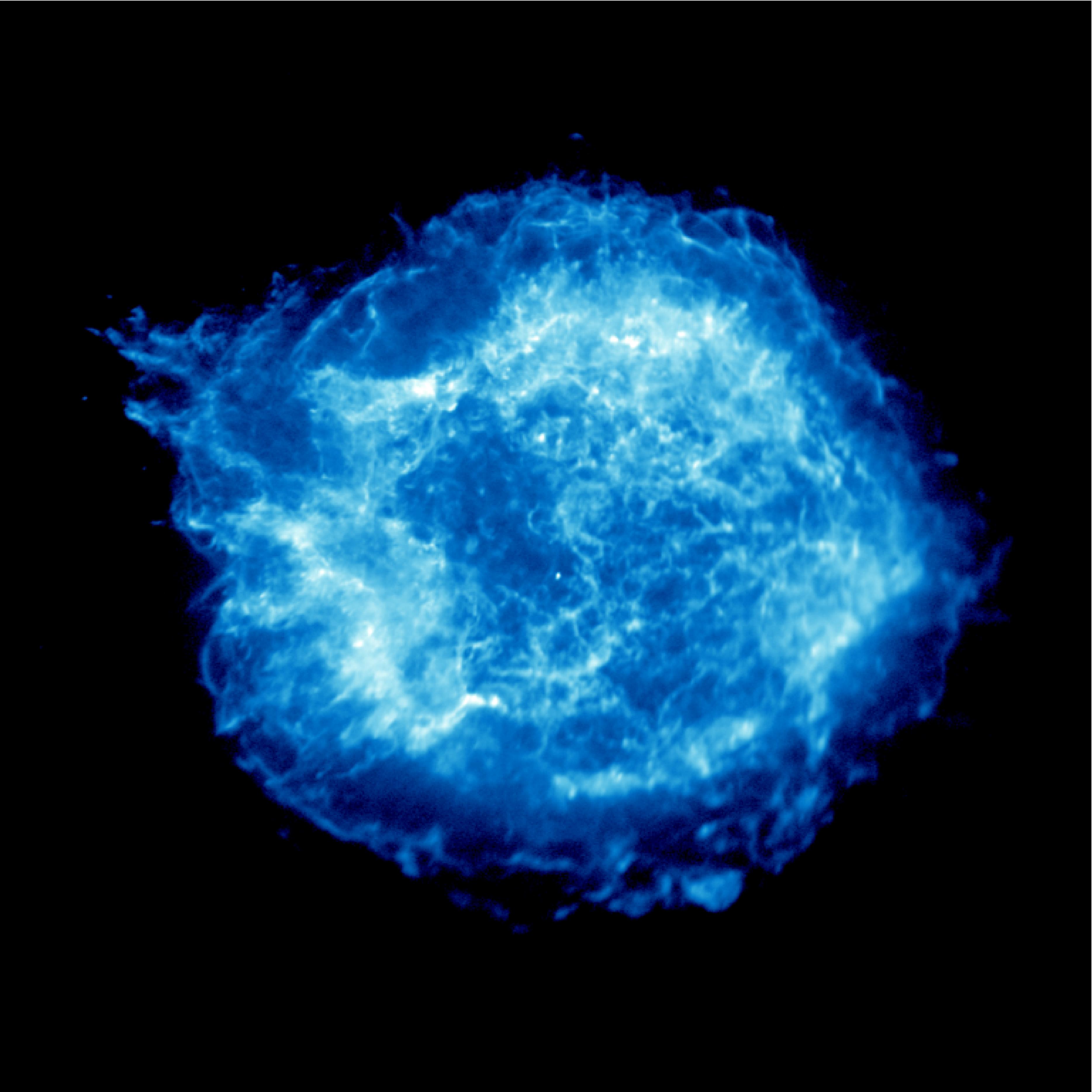 |
| X-ray images of
Cassiopeia A, taken by the Chandra satellite. Cas A is the
gaseous remnant of a supernova, which
exploded around 1680 A.D. The compact remnant, which
is probably a neutron star but no pulsar, can be
seen as bright spot near the geometrical center of
the expanding gas cloud. |
These truely gigantic events have
fascinated astronomers ever since
they had discovered that the night sky is not as unchangeable as it
might seem at first glance. The "new star" whose appearance Chinese
astronomers had reported in 1054 has left a glorious gaseous remnant
now known as the Crab nebula. The term "supernova" for these outbursts
was coined by the Swiss astronomer Fritz Zwicky in 1933, and it was
Zwicky and his colleague Walter Baade who first speculated that
supernovae are the explosions of stars. They suggested that the core of
the star collapses to a neutron star, an ultralarge atomic nucleus
which has the mass of the Sun and the diameter of a big city and
consists mostly of neutrons. The release of gravitational energy during
its formation would be sufficient to power the ejection of the outer
stellar layers in a supernova explosion. It took more than 30 years
before the discovery of a pulsar in the Crab nebula and its
interpretation as a rapidly spinning neutron star confirmed the
existence of such exotic objects and established their role as relics
of supernova explosions.
Supernovae are of pivotal
importance for many questions in astrophysics. Not only does their
extreme energy release heat the interstellar medium and thus has
important influence on the gas dynamics and history of galaxies.
Setting the end point of the life of massive stars, they disseminate
the chemical elements which were assembled during the stars' millions
of years of evolution. The extreme temperatures, densities, and
neutron-richness during the explosion enable the formation of nuclei
heavier than iron and in particular of radioactive material. Elements
that make up the crust and atmosphere of the Earth and form the basis
of life, e.g. carbon, oxygen, silicon, and iron, but also rare,
very heavy elements like gold and uranium, are thus produced and mixed
into the interstellar gas.
The brilliant display of the
explosion that is visible by radiation in different wavelengths, is
actually only a weak aftermath of the violent processes that occur in
the interior of a dying star. The core of a supernova provides the most
extreme conditions in the universe after the big bang. Supernovae are
therefore laboratories of great interest for nuclear and particle
physics. Reactions of electrons and positrons with neutrons and
protons, the constituents of atomic nuclei, produce a huge number of
neutrinos. These neutral elementary particles interact only relatively
weakly with the stellar matter. Because they escape fastest from the
dense center, they carry away about 99 percent of the gravitational
binding energy that is set free during the neutron star formation. The
tiny rest only drives the mass ejection.
 |
| Hubble Space Telescope
image of the Crab Nebula. High-energy particles
accelerated by the Crab pulsar, a neutron star spinning
with a period of 33 ms at the center of the
remnant, cause the bluish glow of the interior.
The outer filaments are the tattered remains of
the star and consist mostly of hydrogen. |
When massive stars evolve quietly
for millions of years, nuclear
reactions build up successively heavier elements inside the stellar
core. In a sequence of accelerating stages hydrogen burns to helium,
helium to carbon and oxygen, these further to neon and magnesium, then
silicon, sulfur and calcium, until finally iron and nickel are formed.
Reaching there, further energy release by nuclear fusion is not
possible, because the nuclei of the iron-group elements have the
highest binding energies per nucleon. The stellar core of iron resists
the pull of its own gravity mostly by the quantum mechanical pressure
of a gas of degenerate electrons and to a smaller degree by the thermal
pressure of the matter. But when the core grows and contracts, its
density and temperature becomes so large that electrons are squeezed
into the atomic nuclei and high-energy photons start breaking up iron
to alpha particles (i.e. helium nuclei) in a process called
photodisintegration. Both reduces the pressure support in the core,
leading to further contraction and accelerated electron captures and
photodisintegration. A catastrophic implosion is thus unavoidable.
Within fractions of a second the stellar core collapses to form a
neutron star.
Only when the density reaches that
of nuclear matter, strong repulsive forces between neutrons and
protons, the constituents of nuclear matter, prevent further
compression and the infall is abruptly stopped. A powerful shock wave
is launched as the outer layers of the stellar core crash with
supersonic speed onto the rebounding central part. For a while it was
thought that this shock waves races directly through the star and
causes its disruption in the supernova explosion. Detailed computer
simulations, however, showed that this does not happen. The shock
expansion is damped by energy losses mainly in photodisintegration
reactions until it finally comes to a halt before the shock is able to
leave the stellar core.
But how is the explosion
initiated? How can the collapse of the stellar core be inverted and
infalling matter be lifted out of the increasingly deeper gravitational
well of the forming neutron star? The answer is not finally clear.
Different possibilities are currently studied with computer models.
Since neutrinos carry away such a huge energy, a widely favored theory
considers them as the driving force of the explosion. Indeed, not all
of the high-energy neutrinos that are radiated from the nascent neutron
star can escape from the stellar interior. Some of them are absorbed in
reactions with neutrons and protons and deposit their energy behind the
stalled supernova shock. If this heating is sufficiently strong, the
shock can be "revived" and the explosion of the star is initiated.
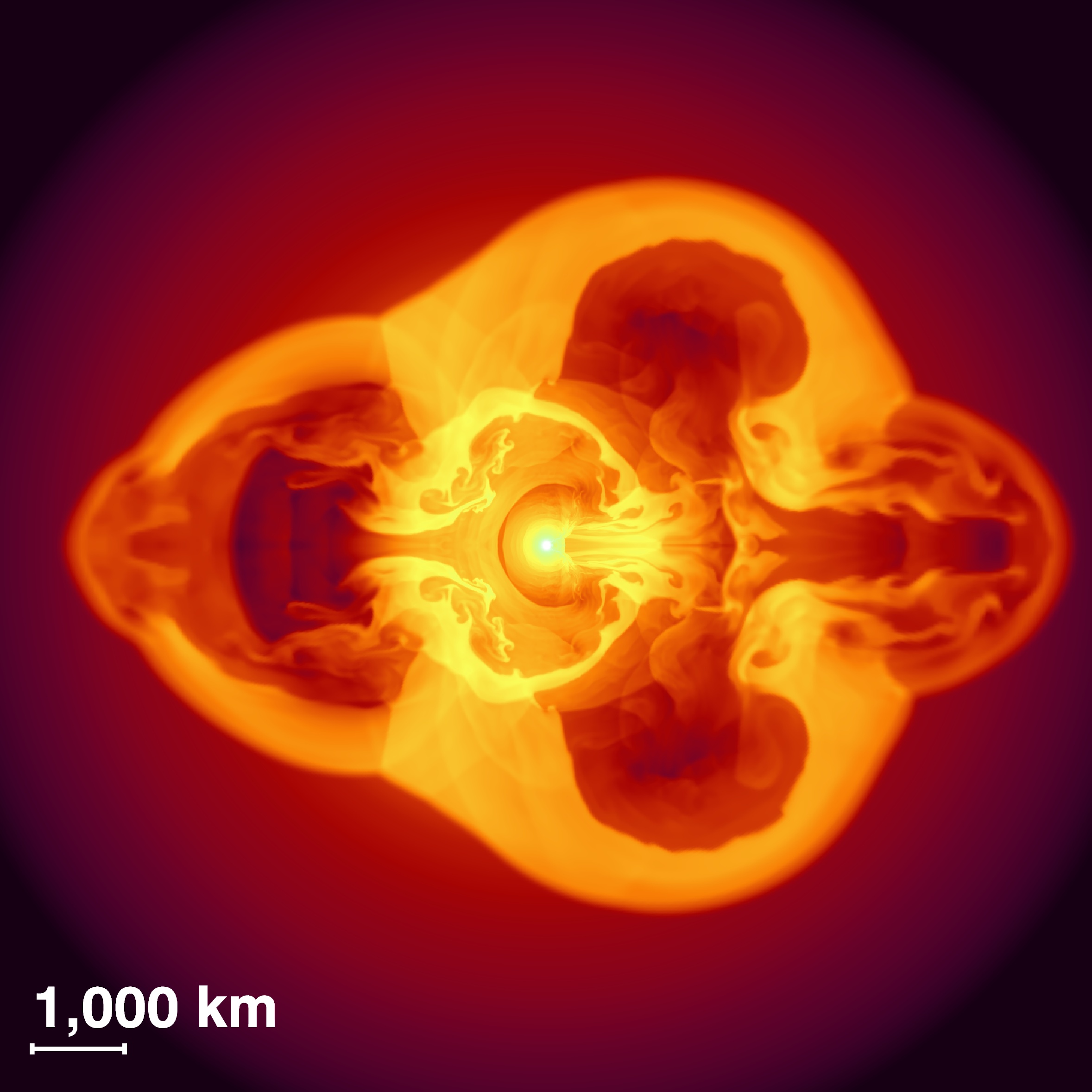 |
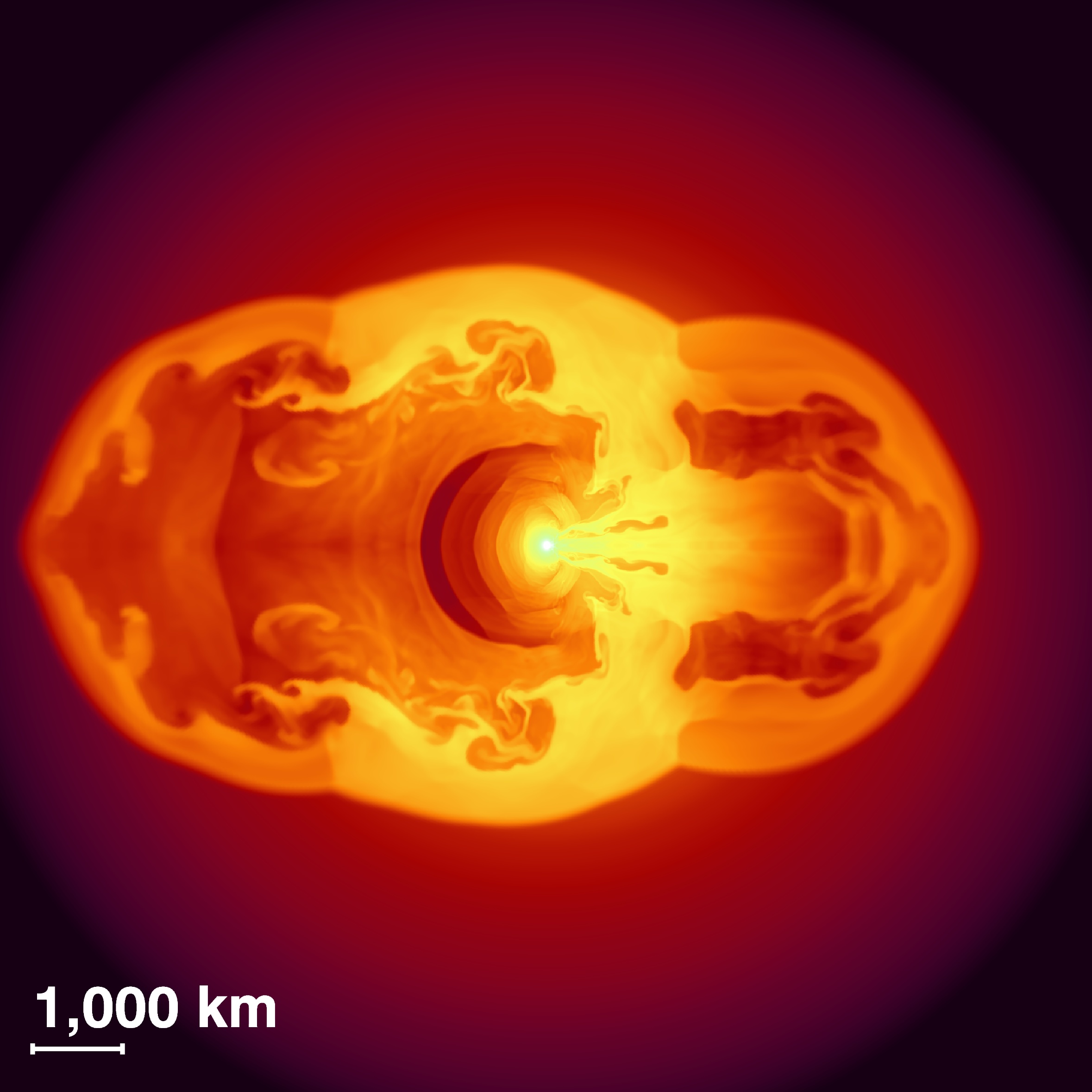 |
| Highly anisotropic
supernova explosions of a 15 solar mass star in two different computer
simulations showing the color coded the gas velocities at one second
after the start of the neutrino-driven explosion. Hydrodynamic
instabilities that grow in the supernova core lead to spontaneous
symmetry breaking and asymmetric mass ejection. In response to this the
neutron star at the center of the explosion can obtain a recoil
velocity of several hundred kilometers per second and in some cases
even more than 1000 km/s, explaining the observed space velocities of
young pulsars. |
For stars between about 8 and 11
solar masses, which are at the low-mass end of those exploding as
supernovae, this so-called neutrino-driven mechanism indeed seems to
work in the computer models.
More massive stars, however, have bigger iron cores and the ram
pressure of the gas which continues to fall onto the stalled shock is
much larger. This damps the expansion of the shock and makes explosions
more difficult. Like water in a pot on a stove, neutrino heating stirs
up the fluid behind the stalled shock in a process known as convection.
The violent boiling of the hot matter causes large deformation of the
shock. If the energy input by neutrinos is strong enough, the gas
motions become so powerful that the star blows up in a highly
asymmetric way.
Computer simulations show that the chemical composition of the exploding star gets mixed between the inner and outer layers. This might explain the anisotropies and clumpiness observed in many supernovae and supernova remnants. It might also explain why many young pulsars are measured with velocities of several hundred or even more than 1000 kilometers per second. While matter is thrown out by the explosion more strongly to one side, the neutron star receives a kick in the opposite direction.
Computer simulations show that the chemical composition of the exploding star gets mixed between the inner and outer layers. This might explain the anisotropies and clumpiness observed in many supernovae and supernova remnants. It might also explain why many young pulsars are measured with velocities of several hundred or even more than 1000 kilometers per second. While matter is thrown out by the explosion more strongly to one side, the neutron star receives a kick in the opposite direction.
It is, however, by no means clear
that neutrinos are really the driving agents of the explosion. Computer
models in three dimensions with a sufficiently accurate description of
the complex neutrino transport and interactions require more power than
current supercomputers can provide. Theorists are therefore not yet
able to give definitive answers. But they are inventive and have
suggested alternative ways to blow up massive stars. Magnetic fields
might do it. Being amplified during the collapse of the stellar core
and by dynamo motions and rapid differential rotation, the fields could
become so strong that magnetic pressure or magnetic heating could
reaccelerate the stalled shock. Also acoustic waves from a vibrating
neutron star were recently proposed as such a backup possibility for
getting explosions. More studies and better models are needed to
clarify the situation.
The puzzle what really happens at
the heart of a supernova, however, may ultimately be unravelled only
through observations. Direct evidence is carried by the intense burst
of neutrinos and by gravitational waves. Such propagating perturbations
of spacetime are prediced by Einstein's theory of general relativity
and should be created by the rapid nonradial mass motions that shatter
the supernova core. Experiments are available and under construction
which are likely to reveal some of the dark secrets of a future
Galactic event.
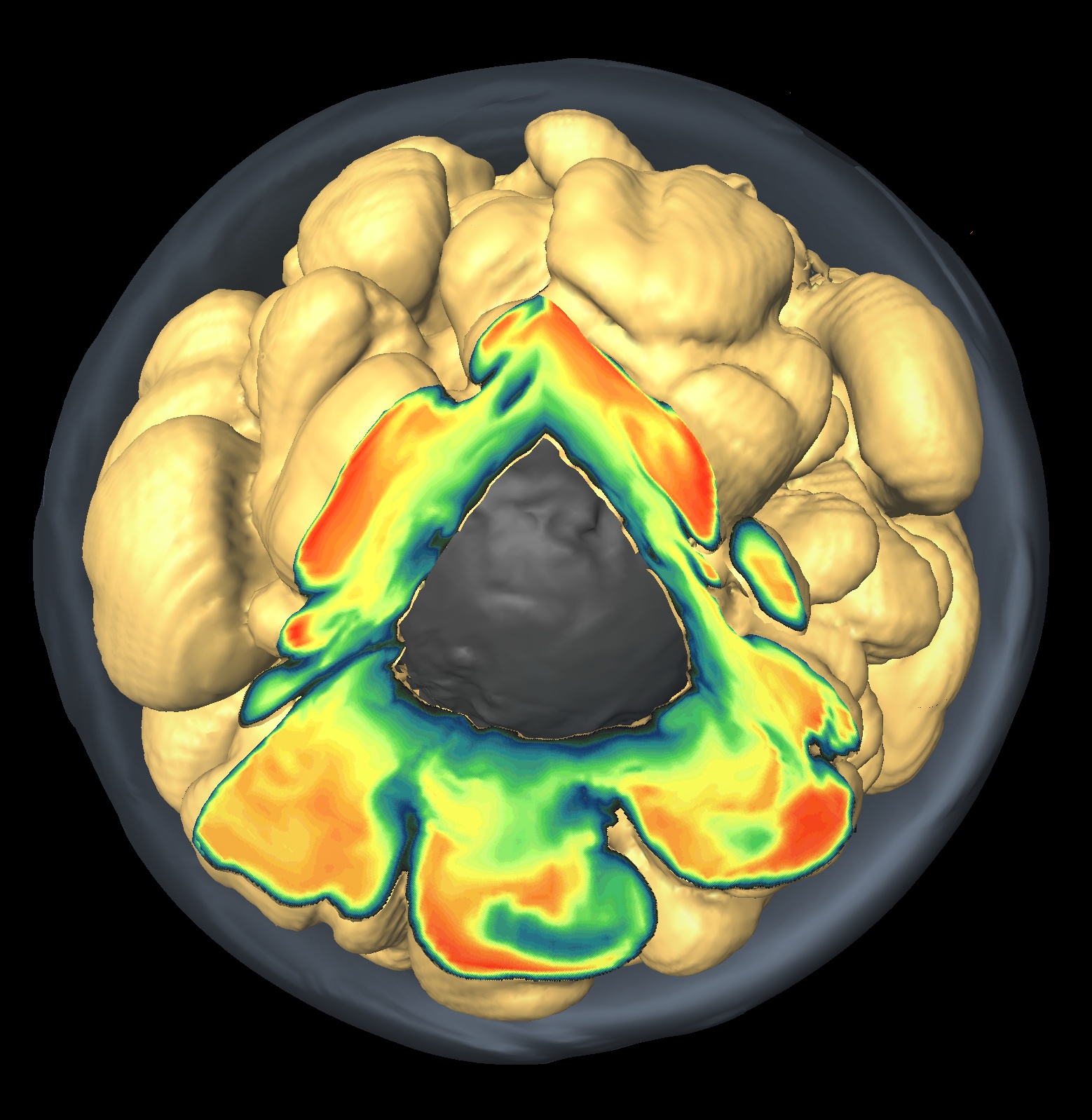 |
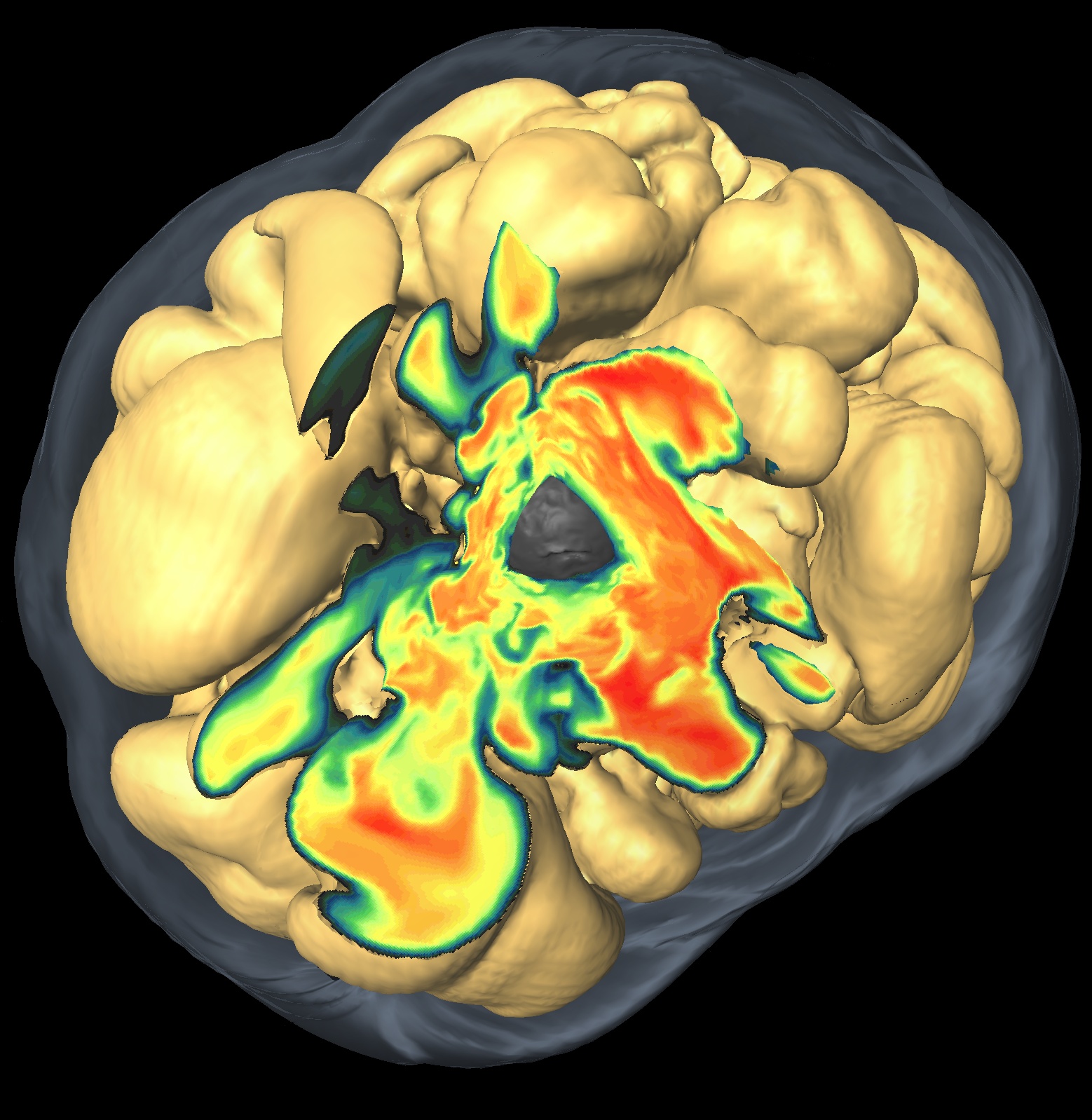 |
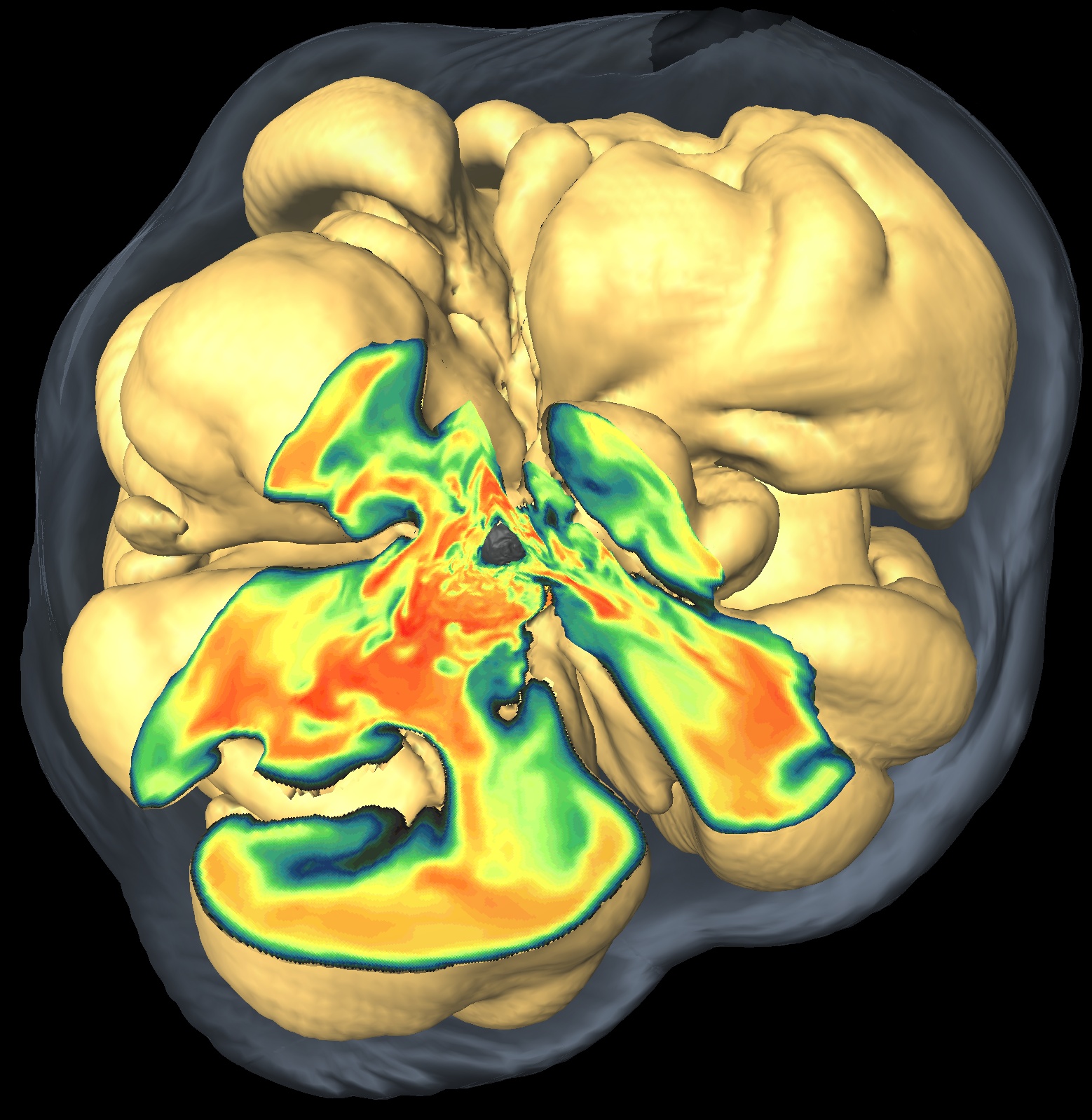 |
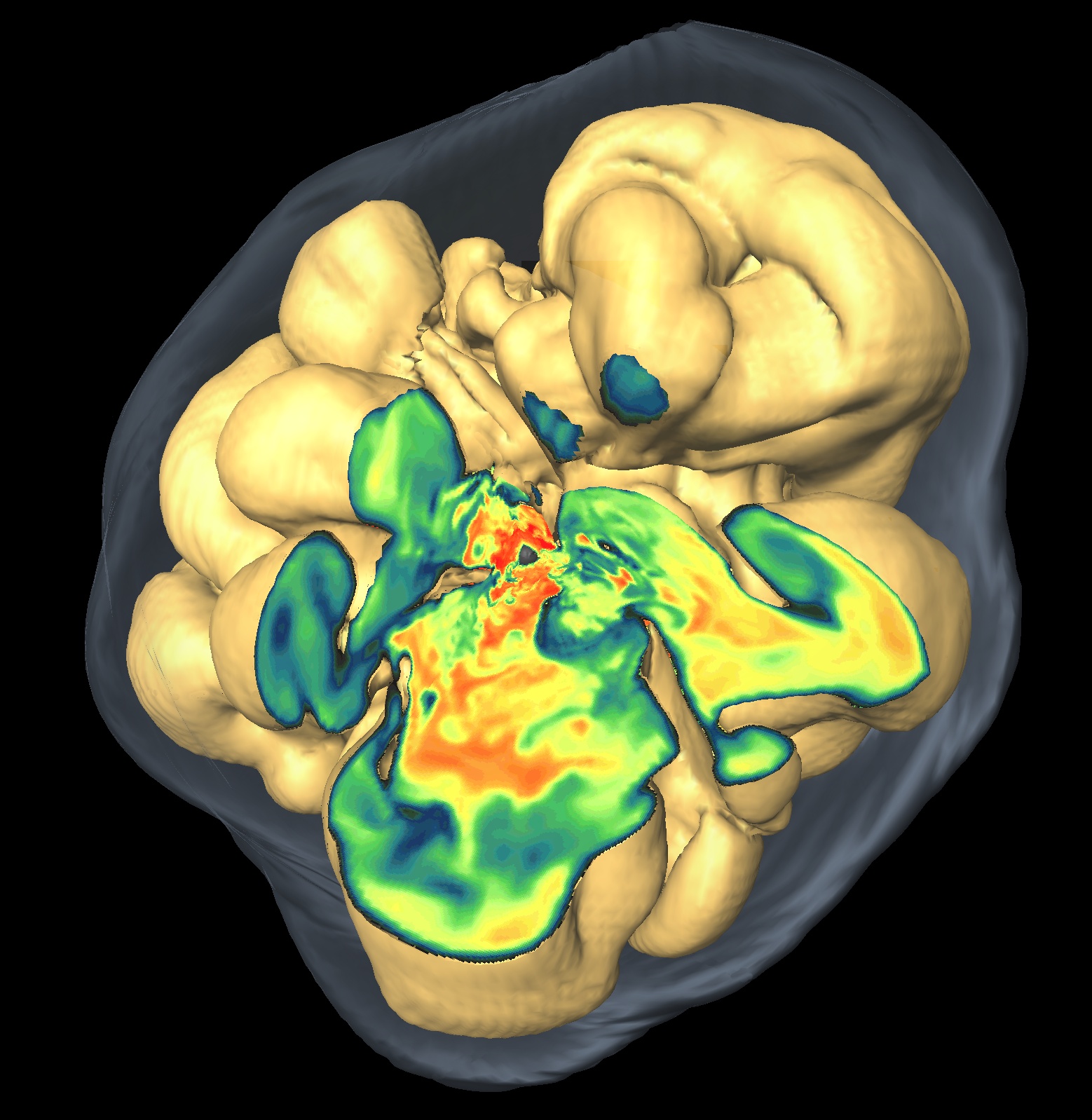 |
| Onset of a
neutrino-driven explosion in a three-dimensional computer simulation. Neutrino absorption
heats the surroundings of the newly formed neutron
star (visible as dark grey surface) and leads to buoyant,
rising bubbles of hot matter which pushes the shock front of the explosion outward. The four snapshots show the violent boiling of the neutrino-heated gas (color coded is the entropy) at 0.1, 0.3, 0.4, and 0.5 seconds after the start of the explosion, which reaches a radius of roughly 2000 kilometers during this time. |
Another long standing mystery has
found its solution only recently. Observations were able to establish
the connection of at least some of the cosmic gamma-ray bursts with
extraordinarily energetic explosions of massive stars in distant
galaxies. These "hypernovae" eject narrowly collimated flows of gas,
so-called jets, which expand nearly at the speed of light and are the
sources of the intense flashes of gamma radiation. The enormous energy
output in these jets and in the stellar explosion may require an even
more violent event than the birth of a neutron star: the collapse of a
star to a stellar-mass black hole. This points to stars more massive
than about 25 solar masses with cores that are too big to remain stable
as neutron stars. If the dying star spins very rapidly, the infalling
stellar gas can not be swallowed by the black hole directly. Instead,
it swirls around the black hole, heats up to very high temperatures,
and releases the huge energy that drives two jets along the rotation
axis and a highly asymmetric, extremely powerful explosion. Gamma-ray
bursts are rare events and thus seem to require a very special
combination of conditions. A key ingredient may be very fast rotation
at the onset of collapse.
Despite remarkable progress in the past years by theory and breakthroughs of observations, our understanding of these fascinating cosmic events is still very incomplete. Many aspects remain uncertain and controversial and demand further exploration. The field of supernova research can be expected to develop rapidly also in the coming years and promises exciting new discoveries and insights.
Despite remarkable progress in the past years by theory and breakthroughs of observations, our understanding of these fascinating cosmic events is still very incomplete. Many aspects remain uncertain and controversial and demand further exploration. The field of supernova research can be expected to develop rapidly also in the coming years and promises exciting new discoveries and insights.